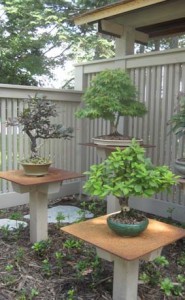Japanese Gardens & Bonsai
 March 29, 2012
March 29, 2012
Bonsai is greatly regarded as an icon of Japanese art and culture. “Bonsai” is a Japanese pronunciation of the earlier Chinese term penzai. Here the “bon” is a tray-like pot typically used in bonsai culture and “sai†means a planting or plantings). The word bonsai is often used in English as an umbrella term for all miniature trees in containers or pots. Bonsai is an art of cultivating miniature trees by careful pruning, wiring and trimming.
It has been believed that the Japanese perfected the art of bonsai. The real challenge lies in making the plants look as beautiful and attractive as those growing in the wild. So it is an art that involves raising living trees, often over a period of several years.
Bonsai can be displayed in your Japanese garden; however you need to be careful when selecting a location that does not conflict with your garden. I personally recommend that you keep bonsai within Japanese gardens to a small display area with one to three bonsai plants. If you have a larger collection you may want to design and build a bonsai display garden, like the one pictured; which is of one of our projects here in Minnesota. This garden can be also be very Japanese, the difference from it and a Japanese garden is that a bonsai garden is designed with the primary purpose of displaying a collection of bonsai. This type of garden can stand on it own or be attached to a Japanese garden. Being attached allows visitors of your authentic Japanese garden to experience it for the art and joy of the garden and then enjoy a separate garden room for the purpose of enjoying the art of your Bonsai. Basically speaking the purpose of each garden and the intended experiences are very different and when possible are off better off separated. Again, if you only have a couple of bonsai you can select a small display area in your Japanese garden.
Japanese researched and worked hard to produce magnificent bonsai through years of pruning, wiring and careful attention. The Japanese art of bonsai, and its precursor, the Chinese art of penjing, are rooted in the traditions of Asian culture.
Japanese regard this art as an extremely challenging task because it requires physical and emotional commitment. Bonsai, which best expresses the beauty and significance of life has become an integral part of Japanese culture and tradition. The care taken for creating and shaping a bonsai is considered a form of meditation. For Japanese, the art of bonsai is marked by timelessness since it evolves and develops as long as the plant is alive.
Over time, bonsai began to take on different styles and spread to different parts of the world. In Minnesota, Bonsai varied immensely from one another. Today, hardy as well as tropical indoor bonsai are trained in classic styles, including windswept, slanted trunk, rock clinging, and forest.
Bonsai can also grow in your gardens here inMinnesota. It is as an art form that is an intricate craft that involves both sensitive aesthetics and horticultural skill. The plant goes through a whole lot of changes during its transformation towards becoming a bonsai. Requiring a long time of devoted attention and care to produce, the bonsai extends beauty and expresses the significance of life in your garden. The care involved in creating and shaping a bonsai is considered a form of meditation in and of itself.
For growing a bonsai first thing you must do to create a beautiful bonsai is to pick the right tree to use. A few trees have a better disposition to be turned into a bonsai. Flora which works best to become miniature trees are the ones that already have smaller leaves to begin with.
After picking the tree which can bloom as a bonsai, the next task is planting that tree and it requires getting a pot. The pot must be able to hold the plant’s roots. Once you have happily completed your own thing of beauty, you should become well-known with the basic guidelines for always keeping the tree in good health so that it can repay you with years of enjoyment. You will also need to cover the roots with good soil. The planting medium must have a combination of organic material, pumice, sand and garden soil.
You must understand the method and consistency of providing water, pruning and re-potting, lighting requirements, avoidance of illnesses and insects, as well as plant fertilization. Being able to cultivate your tree properly will take devotion but the rewards of seeing your tree flourish with the good care you provide it will pay you back with a real sense of satisfaction appreciation for years to come. Enjoy your new hobby.
The most frequently used plants are pines, cherry, maples and plum. Some fruit bearing trees like the quince and persimmon are also used for bonsai. In reality, bonsai trees are regular trees that are grown following years of pruning, wiring and careful attention.
If you would like our help with your Japanese garden project please contact us, Niwa Design Studio, at 952-470-1882.
You can also visit Japanese Garden Journal for more information about Japanese Gardens.

 Posted in
Posted in  content rss
content rss